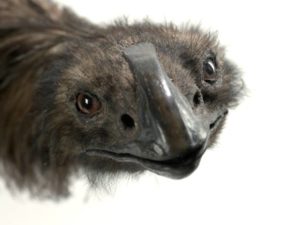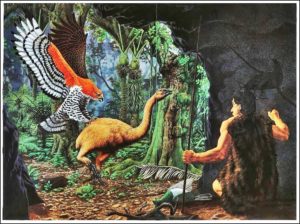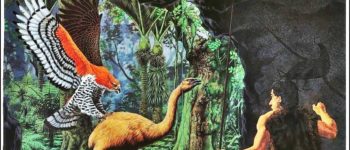1430: When Eagle Was Sovereign
December 30, 2020
By AHNZ
The Mighty sky predator: Haast’s Eagle.
Speciality: bi-pedal prey.
600 years extinct due to running out of moa to prey upon.
By First Contact, Maoris had only the vaguest knowledge that either the eagle or the moa had existed. The people who were in New Zealand before, the Moa Hunters, would have known both of these birds well.

When Eagle Was Sovereign
When Moa Hunters out-competed Haast’s eagle for the moa what happened? I bet the last of the eagles became desperate and cunning for the only substitute animal on the menu: man.
The last of their species were perhaps hunters of women and children, the terror of the tribes. These birds, I imagine, would have been the most desperate and blood-thirsty, the most cunning and daring and willing to pick off humans. For the sake of survival they would need to be excellent man killers. I’m sure the last of the Haast (or, Hokioi as they may also have been called) were the meanest and most legendarily terrifying. Hungry sovereigns of New Zealand.
“Pouakai the monster, sometimes also known as Hokioi, was a fabled flying beast which would snatch unwary children who ventured out too early in the mornings or stayed away from their homes late in the evenings. These stories are part of the tribal lore of most Taranaki, Tainui and Whanganui tribes.”- The man – killer that came from the sky, Tom O’Connor, Taranaki Daily News; Stuff (2009)
Moa Hunter (and Maori, if yet arrived) would, during this time, be afraid to leave the protection of the thick forests and so unwilling to brave exposed places like rivers and coasts. After the honeymoon of plentiful moa, I think there must have been a cultural period of humans living in fear of the open. This must have held back the fishing and agricultural culture of the Maoris, requiring them to keep to the cover of bush and the food offered there. This ‘Dark Age’ would have ended when the eagle finally became extinct, giving dawn to a new age.
“A great bird does, in fact, form the subject of one of the few Waitaha existing legends. This bird, ‘Pouakai’, had its nest on the slopes of Mount Torlesses and periodically swooped down to the flats at great speed to carry off women and children as food for its young. The people were terrified of it and yet were powerless to prevent its ravages.”- Hawkins (1957)
Canterbury Waitaha and the Taranaki Maori both share the legend of Pouakai, a great winged eagle that preyed on women and children. In the end the warrior men slew it but perhaps what really defeated the last eagles was man’s superior ability to the moa as prey to evade death from above.
—
Ref. Beyond the Waimakariri, Don Hawkins (1957
Image ref. Unknown. The artist seems to think as I do, that the man had better stay in his cave away from the alpha predator of these islands or he will be its next meal
Note: The plumage of the illustrated eagle matchs the description given to George Grey: Black-and-white birds with a red crest and yellow-green tinged wingtips. The Pouakai, Hokioi, or Hakawai; Ref. Wiki
Note: This eagle may also be Sinbad the Sailor’s ‘Roc‘ which would tie in well with the mystery of the Tamil Bell
Note: The Haast Eagle was discovered in 1871 by Julius von Haast
 Like Comment Share
Like Comment Share






